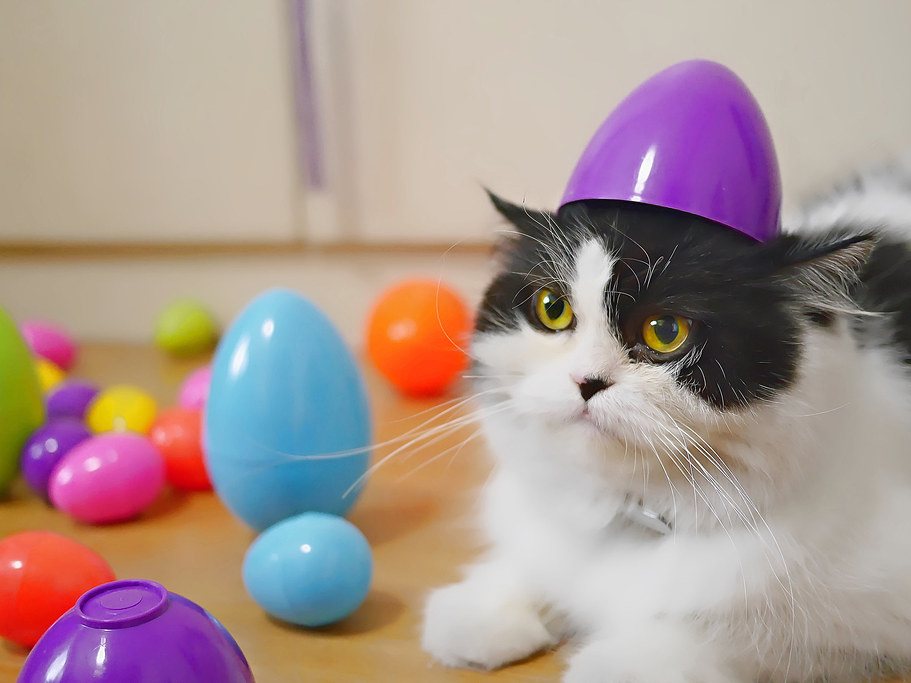Hop To It: Tips For A Pet-Safe Easter
For many people, the start of spring is accompanied by an Easter holiday that brings loved ones together in a joyful celebration involving many traditions. For those with furry family members, it is important to note that some of these traditions might introduce new hazards into their pet’s environment.

Dr. Lori Teller, an associate professor in the Texas A&M College of Veterinary Medicine & Biomedical Sciences, says that some Easter decorations can put pets at risk.
Easter lilies, in particular, are extremely toxic to cats; even just a small lick of pollen from the flower or nibble of leaf can lead to severe kidney failure and death, with symptoms developing within six to 12 hours after exposure.
Curious cats may also be tempted by the plastic grass in Easter baskets, which can cause an intestinal obstruction and require emergency surgery.
Dogs may be tempted by rotten eggs left unfound after an egg hunt and become ill after consuming them.
“The signs of toxicity will vary depending on what the pet has been exposed to,” Teller said. “Symptoms of Easter lily toxicity include vomiting, inappetence (having a lack of appetite), lethargy, changes in urination (too much or not enough), water consumption (not drinking or excessive thirst), or, rarely, disorientation and seizures. Signs of gastrointestinal obstruction can include retching and attempts at vomiting, inappetence, straining to pass a bowel movement, and abdominal pain.”
Owners who suspect that their pet has been exposed to an Easter hazard should seek veterinary care for their animal immediately.
Easter treats that are harmless to humans may also become dangerous if consumed by a pet. Chocolate is well-known to be toxic to pets. Chocolate toxicity can cause vomiting, diarrhea, tremors, seizures, heart arrhythmias, and other symptoms, including coma and death. Teller says that, the darker the chocolate, the more toxic it is.
“Owners should be cautious about sharing any human foods with their pets. For many pets, ham or lamb may be too rich or fatty and the bones can be dangerous, especially if a dog were to break off and swallow large splinters,” Teller said. “The risks of ham or lamb and their bones can be gastrointestinal obstruction, intestinal perforation, vomiting and diarrhea, or pancreatitis.”
The hot cross buns many people serve with their Easter brunch may also be dangerous if they contain the common baking ingredient Zante currants, which are actually small grapes and are toxic to dogs. True red, black, or white currants are not toxic to dogs.
Teller says that while it’s best not to feed pets from the table any time of year, it is especially important not to do so when potentially dangerous foods and unknowing guests are present. She recommends putting particularly insistent pets in another room with a pet-safe Easter treat of their own.
“People want to include their pets in the Easter fun, so make a pet-safe Easter basket and fill it with some dog or cat treats and toys,” Teller said. “Instead of a basket, you could use a new pet bed. You could also fill some plastic eggs with catnip or fill some puzzle toys with dog treats and hide those so your dog can participate in the Easter egg hunt.”
Although your pet may not be able to participate in all the Easter festivities, they can still take part in this holiday with a few adjustments. Happy Easter!
Pet Talk is a service of the College of Veterinary Medicine & Biomedical Sciences, Texas A&M University. Stories can be viewed on the web at vetmed.tamu.edu/news/pet-talk. Suggestions for future topics may be directed to editor@cvm.tamu.edu.


